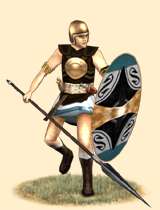Iberi Scutari (Iberian Medium Spearmen)
 |
Weapons | Defence | Mental | ||||||
|---|---|---|---|---|---|---|---|---|---|
| Primary | Secondary | Armour: | 8 | Morale: | 13 | ||||
| Type: | spear | spear | Shield: | 3 | Discipline: | disciplined | |||
| Attack: | 6 | 15 | Skill: | 11 | Training: | highly_trained | |||
| Charge: | 6 | 6 | Recruitment | Other | |||||
| Lethality: | 1 | 0.13 | Soldiers: | 40 | Hit Points: | 1 | |||
| Range: | 36.8 | 0 | Cost: | 1785 | Mass: | 1.1 | |||
| Ammo: | 2 | 0 | Upkeep: | 446 | |||||
| Turns: | 1 | ||||||||

Iberian Scutari are tough, fast and well-equipped medium spearmen that form the main battle line in Iberian armies. Although having advantage fighting against cavalry, they are very dangerous against enemy light infantry and can hold their own against heavy troops.
Expert at Hiding in Woods
Can Hide in Long Grass
Sapping Ability
These Iberian spearmen are referred to as Scutarii by the Romans because of their large oval shields (the Latin word for shield being "Scutum"). They are well-equipped medium spearmen, being armed with the dreaded all-metal soliferum, a spear as their main weapon, a short straight sword and a small dagger for backup. They protect themselves with a combination of leather armour and bronze breastplate. When all this equipment is put together you are left with an extremely versatile and quick infantry. As more permanent warriors than the Caetratii, they are more experienced and skilled, as well as better equipped and protected, generally forming the main line in Iberian armies. They use their "soliferum" before closing in for hand-to-hand combat. Although being considered by enemies as heavier troops then the Caetratii, they are, nevertheless, fast and come in handy when springing tactical ambushes on enemy units. Most Iberian warriors were known for their determination and skill and Scutarii are no exception. They are, with the traditional Iberian ferociousness, quite determined.
Historically, the design of the later Roman legionary sword (or "gladius") was influenced by the blades carried by these men (known by the Romans as "gladius hispanniensis"). This design was adopted after Roman armies had faced large formations of Scutarii during the First Punic War.
Centuries of feuding among the Iberian tribes hardened the people in such a way that there was no shortage of tough, determined and cunning warriors. Iberians used varied weapons, shields and armour, differing according to region, wealth, specific battlefield tasks and personal preference - most swords ("falcatas" and "gladius hispanniensis") were custom built to suit the arm length, weight and strength of it's owner. Even though Iberian tactics were generally constant and specific, they were also unpredictable and very effective when properly used. The Iberians' ability to hide, while keeping their enemy under close watch, before performing coordinated attacks followed by swift retreats, allowed them to surprise enemies when least expected. These Iberian hit and run tactics were called by the Romans "concursare", and sometimes described as "simple absence of tactics". It is known, however, that to perform these coordinated attacks and retreats, across an entire army, in simultaneous different areas, needed an impressive amount of organization and signaling that was probably performed through the use of commonly found rounded ceramic horns. Although the many tribes that populated Iberia never became united under a single ruler before the Roman invasions, several temporary alliances against foreign enemies were known. These alliances, linked to the Iberians' great determination to remain independent of any foreign power, constituted a unenviable obstacle that put Carthage and Rome at check for more than a century.